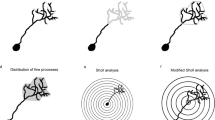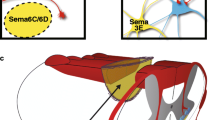Summary
If an axonal lesion is made close enough to the cell body, injured olfactory neurons degenerate and are replaced by new nerve cells arising from undifferentiated mucosal basal cells. Therefore, under these conditions neural regeneration occurs through a process similar to neuronal development. The use of the long garfish olfactory nerve has revealed that neuronal death is not an inevitable consequence of an axonal injury and that the extent of cell death depends on the distance between the site of injury and the perikaryon. A lesion located up to 40 mm from the cell body induces the death of all mature neurons. Between 60 and 100mm an increasing proportion of neurons survive the injury (from 60 to more than 90%) and are able to regenerate their distal segment. During regeneration, two populations of growing axons have been characterized. The fastest growing fibres (5.8mm per day) correspond to the small population of neurons which were already growing at the time of the lesion and are able to survive an injury at any distance along the nerve. The majority of the regenerating fibres grow at 0.8mm per day and corresponds to the damaged mature neurons.
Elongation velocities were not affected by the distance from injury to cell body or by the mode of neural repair (development or regeneration). The initial delay between the injury and the beginning of elongation increases linearly with distance at a rate of 1 day cm−1 and is independent of the elongation velocity of the growing neurons. This indicates that the mechanism responsible for the beginning of axonal growth is initiated at or near the cell body and involves the entire axonal stump and not only the area surrounding the crush site. The ability of nerve cells to survive an injury may depend on the length of the axonal stump remaining attached to the cell body and on the level of protein synthesis at the time of the crush. From preliminary results it can be hypothesized that the length of the initial delay is determined by a reorganization of the cytoskeletal elements in the proximal axonal stump.
Similar content being viewed by others
References
Bisby, M. A. &Bulger, V. T. (1977) Reversal of axonal transport at a nerve crush.Journal of Neurochemistry 29, 313–20.
Black, M. M. &Lasek, R. J. (1976) The use of axonal transport to measure axonal regeneration in rat ventral motor neurons.Anatomical Record 184, 360–1.
Camara, C. G. &Harding, J. W. (1984) Thymidine incorporation in the olfactory epithelium of mice: early exponential response induced by olfactory neuroectomy.Brain Research 308, 63–8.
Cancalon, P. (1979) Influence of temperature on the velocity and on the isotope profile of slowly transported labeled proteins.Journal of Neurochemistry 32, 997–1007.
Cancalon, P. (1983a) Regeneration of three populations of olfactory axons as a function of temperature.Developmental Brain Research 9, 265–78.
Cancalon, P. (1983b) Influence of temperature on slow flow in populations of regenerating axons with different elongation velocities.Developmental Brain Research 9, 279–89.
Cancalon, P. (1983c) Proximodistal degeneration of C-fibers detached from their perikarya,Journal of Cell Biology 97, 6–14.
Cancalon, P. (1983d) Receptor cells of the catfish olfactory mucosa.Chemical Senses 8, 203–9.
Cancalon, P. (1984) The relationship of slow axonal flow to nerve elongation and degeneration. InAxonal Transport in Neuronal Growth and Regeneration (edited byElam, J. S. &Cancalon, P.), pp. 211–41. New York: Plenum Press.
Cancalon, P. (1985) Influence of temperature on various mechanisms associated with neuronal growth and nerve regeneration.Progress in Neurobiology 25, 27–92.
Cancalon, P. (1986) Nerve regeneration as a function of the distance cell body-axonal lesion.Transactions of the American Society for Neurochemistry 17, 133.
Cancalon, P. (1987) Slow flow and the initial delay of axonal regeneration. InAxonal Transport (edited bySmith, R. &Bisby, M. A.), pp. 223–41. New York: Alan R. Liss.
Cancalon, P. &Elam, J. S. (1980a) Study of regeneration in the garfish olfactory nerve.Journal of Cell Biology 84, 779–94.
Cancalon, P. &Elam, J. S. (1980b) Rate and composition of rapidly transported proteins in regenerating olfactory nerves.Journal of Neurochemistry 35, 889–97.
Carlsen, R. C. (1983a) Regeneration of sciatic nerve in frogs maintained at 15 ° C. Failure to sustain a regeneration after initiation.Experimental Neurology 82, 159–71.
Carlsen, R. C. (1983b) Delayed induction of the cell body response and enhancement of regeneration following a condition/test lesion of frog peripheral nerve at 15 ° C.Brain Research 279, 9–18.
Cragg, B. G. (1970) What is the signal for chromatolysis?Brain Research 23, 2–21.
Egan, D. A., Flumerfelt, B. A. &Gywn, D. G. (1977a) Axon reaction to the red nucleus of the rat. Perikaryal volume changes and the time course of chromatolysis following cervical and thoracic lesions.Acta neuropathologica (Berlin) 37, 13–9.
Egan, D. A., Flumerfelt, B. A. &Gywn, D. G. (1977b) A light and electron microscopic study of axon reaction in the red nucleus of the rat following cervical and thoracic lesions.Neuropathology and Applied Neurobiology 3, 423–39.
Friede, R. L. &Bischhausen, R. (1980) The fine structure of stumps of transected nerve fibers in subserial sections.Journal of the Neurological Sciences 44, 181–203.
Fry, F. J. &Cowan, W. M. (1972) A study of retrograde cell degeneration in the lateral mamillary nucleus of the cat, with special reference to the role of axonal branching in the preservation of the cell.Journal of Comparative Neurology 144, 1–24.
Glover, R. A. (1967) Sequential cellular changes in the nodosal ganglion following section of the vagus nerve at two levels.Anatomical Record 157, 248 (Abstract).
Grafstein, B. (1983) Chromatolysis reconsidered — a new view of the reaction of the nerve cell body to axonal injury. InNerve, Organ and Tissue Transplantation: Research Perspectives (edited bySeil, F. J.), pp. 37–50. New York: Academic Press.
Grafstein, B. &McQuarrie, I. G. (1978) Role of the nerve cell body in axonal regeneration. InNeuronal Plasticity (edited byCotman, C. W.), pp. 155–95. New York: Raven Press.
Graziadei, P. P. C. &Monti-Graziadei, G. A. (1978) Continuous nerve cell renewal in the olfactory system. InHandbook of Sensory Physiology (edited byJacobson, M.), pp. 955–83. Berlin: Springer-Verlag.
Gross, G. W. &Beidler, L. M. (1973) Fast axonal transport in the C-fibers of the garfish olfactory nerve.Journal of Neurobiology 4, 413–28.
Humbertson, A. J. (1963) A chronological study of the degenerative phenomena of dorsal root ganglia cells following section of the sciatic nerve.Anatomical Record 145, 244 (Abstract).
Kristensson, K. &Olsson, Y. (1975) Retrograde transport of horseradish peroxidase in transected axons. II. Relations between rate of transfer from the site of injury to the perikaryon and the onset of chromatolysis.Journal of Neurocytology 4, 653–61.
Laser, R. J. (1981) The dynamic ordering of neuronal cytoskeletons. InThe Cytoskeleton and the Architecture of the Nervous System, Vol. 19 (edited byLasek, R. J. &Shelanski, M.), pp. 125–35. The Neurosciences Research Program Bulletin, Boston: MIT.
Lieberman, A. R. (1971) The axon reaction: a review of the principal features of perikaryal responses to axon injury.International Review of Neurobiology 14, 49–124.
Lieberman, A. R. (1974) Some factors affecting retrograde neuronal responses to axonal lesions. InEssays on the Nervous System (edited byBellairs, R. &Gray, E. G.), pp. 71–105. Oxford: Clarendon Press.
Liu, C.-N. (1955) Time pattern in retrograde degeneration after trauma of central nervous system of mammals. InRegeneration in the Central Nervous System (edited byWindle, W. F.), pp. 84–93. Springfield, Illinois: Thomas.
Loewy, A. D. &Schader, R. E. (1977) A quantitative study of retrograde neuronal changes in Clarke's column.Journal of Comparative Neurology 171, 65–81.
McQuarrie, I. G. (1985) Effect of a conditioning lesion on axonal sprout formation at nodes of Ranvier.Journal of Comparative Neurology 231, 239–45.
Monti-Graziadei, G. A. &Graziadei, P. P. C. (1979) Neurogenesis and neuron regeneration in the olfactory systems of mammals. II. Degeneration and reconstruction of the olfactory sensory neurons after axotomy.Journal of Neurocytology 8, 197–213.
Reh, T. &Kalil, K. (1982) Functional role of regrowing pyrimidal tract fibers.Journal of Comparative Neurology 211, 276–83.
Singer, P. A., Mehler, S. &Fernandez, H. L. (1982) Blockade of retrograde axonal transport delays the onset of metabolic and morphologic changes induced by axotomy.Journal of Neuroscience 2, 1279–306.
Watson, W. E. (1968) Observations on the nucleolar and total cell body nucleic acid of injured nerve cells.Journal of Physiology (London) 196, 655–76.
Yin, H. S. &Selzer, M. E. (1983) Axonal regeneration in lamprey spinal cord.Journal of Neuroscience 3, 1135–44.
Zottoli, S. J., Hangen, D. H. &Faber, D. S. (1984) The axon reaction of the goldfish Mauthner cell and factons that influence its morphological variability.Journal of Comparative Neurology 230, 497–516.
Author information
Authors and Affiliations
Rights and permissions
About this article
Cite this article
Cancalon, P.F. Survival and subsequent regeneration of olfactory neurons after a distal axonal lesion. J Neurocytol 16, 829–841 (1987). https://doi.org/10.1007/BF01611989
Received:
Revised:
Accepted:
Issue Date:
DOI: https://doi.org/10.1007/BF01611989




